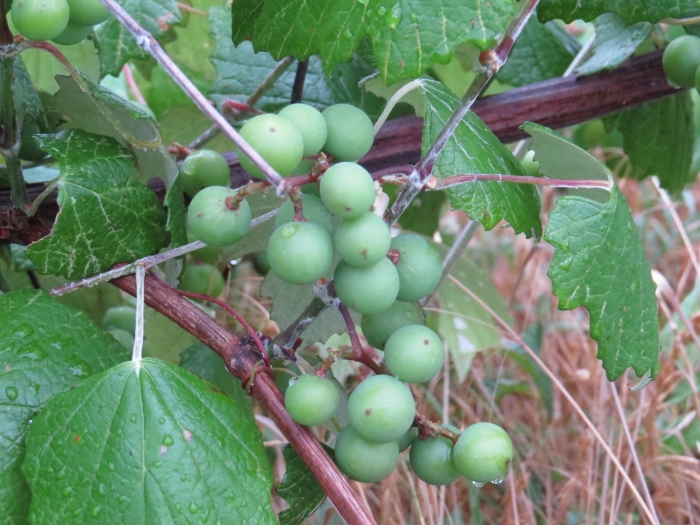Mustang Grape
(Vitis mustangensis)
Mustang Grape (Vitis mustangensis)
/
/

Michael D Fox
CC BY 4.0
Image By:
Michael D Fox
Recorded By:
Copyright:
CC BY 4.0
Copyright Notice:
Photo by: Michael D Fox | License Type: CC BY 4.0 | License URL: http://creativecommons.org/licenses/by/4.0/ | Rights Holder: Michael D Fox | Publisher: iNaturalist | Date Created: 2014-05-26T06:44:05-07:00 |





















Estimated Native Range
Summary
Vitis mustangensis, commonly known as Mustang Grape, is a deciduous, woody vine native to the woodland edges and riverbanks of the southern United States, particularly in Mississippi, Alabama, Louisiana, Texas, and Oklahoma. It can grow to a length of 40 feet (12 meters) or more, with a thick trunk and bark that peels off in strips. The leaves are large, leathery, and heart-shaped, providing dense foliage. From May to July, it produces small, inconspicuous greenish-white flowers, followed by clusters of hard, green fruit that ripen into dark purple berries from July to September. The fruit is notably acidic and astringent when raw.
Mustang Grape is valued for its hardiness and adaptability, often used for wildlife habitats and erosion control. It thrives in full sun to part shade and prefers well-drained soils, tolerating a range of soil types from sandy to clay. While it is drought-tolerant once established, regular watering can enhance fruit production. In cultivation, it is commonly used for jellies, pies, wine, and grape juice. The vines are vigorous and can be trained on trellises, arbors, or allowed to cover trees and fences for a naturalized look. However, gardeners should be cautious as the sap and fruit can cause dermatitis.CC BY-SA 4.0
Mustang Grape is valued for its hardiness and adaptability, often used for wildlife habitats and erosion control. It thrives in full sun to part shade and prefers well-drained soils, tolerating a range of soil types from sandy to clay. While it is drought-tolerant once established, regular watering can enhance fruit production. In cultivation, it is commonly used for jellies, pies, wine, and grape juice. The vines are vigorous and can be trained on trellises, arbors, or allowed to cover trees and fences for a naturalized look. However, gardeners should be cautious as the sap and fruit can cause dermatitis.CC BY-SA 4.0
Plant Description
- Plant Type: Vine
- Height: 26-30 feet
- Width: 15-20 feet
- Growth Rate: Rapid
- Flower Color: Green, White
- Flowering Season: Spring, Summer
- Leaf Retention: Deciduous
Growth Requirements
- Sun: Full Sun
- Water: Medium
- Drainage: Fast, Medium, Slow
Common Uses
Edible*Disclaimer: Easyscape's listed plant edibility is for informational use. Always verify the safety and proper identification of any plant before consumption.
Natural Habitat
Woodland edges and riverbanks
Other Names
Common Names: Texas Grape
Scientific Names: , Vitis mustangensis, Vitis candicans, Vitis candicans, Vitis candicans, Vitis candicans var. diversa, Vitis mustangensis var. diversa, Vitis vinifera subsp. unranked, Vitis vinifera var. candicans,
GBIF Accepted Name: